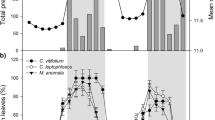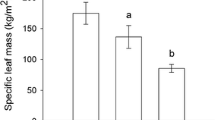Abstract
Leaf phenology is important to herbivores, but the timing and extent of leaf drop has not played an important role in our understanding of herbivore interactions with deciduous plants. Using phylogenetic general least squares regression, we compared the phenology of leaves of 55 oak species in a common garden with the abundance of leaf miners on those trees. Mine abundance was highest on trees with an intermediate leaf retention index, i.e. trees that lost most, but not all, of their leaves for 2–3 months. The leaves of more evergreen species were more heavily sclerotized, and sclerotized leaves accumulated fewer mines in the summer. Leaves of more deciduous species also accumulated fewer mines in the summer, and this was consistent with the idea that trees reduce overwintering herbivores by shedding leaves. Trees with a later leaf set and slower leaf maturation accumulated fewer herbivores. We propose that both leaf drop and early leaf phenology strongly affect herbivore abundance and select for differences in plant defense. Leaf drop may allow trees to dispose of their herbivores so that the herbivores must recolonize in spring, but trees with the longest leaf retention also have the greatest direct defenses against herbivores.




Similar content being viewed by others
References
Aerts R (1995) The advantages of being evergreen. Trends Ecol Evol 10:402–407
Aide TM (1992) Dry season leaf production—an escape from herbivory. Biotropica 24:532–537
Aide TM (1993) Patterns of leaf development in a tropical understory community. Ecology 74:455–466
Augspurger CK (2008) Early spring leaf out enhances growth and survival of saplings in a temperate deciduous forest. Oecologia 156:281–286
Augspurger CK, Cheeseman JM, Salk CF (2005) Light gains and physiological capacity of understorey woody plants during phenological avoidance of canopy shade. Funct Ecol 19:537–546
Axelrod DI (1966) Origin of deciduous and evergreen habits in temperate forests. Evolution 20:1–15
Chabot BF, Hicks DJ (1982) The ecology of leaf life spans. Annu Rev Ecol Syst 13:229–259
Connor EF, Faeth SH, Simberloff D (1983) Leafminers on oak—the role of immigration and in site reproductive recruitment. Ecology 64:191–204
Connor EF, Adamsmanson RH, Carr TG, Beck MW (1994) The effects of host-plant phenology on the demography and population dynamics of the leaf mining moth, Cameraria hamadryadella (Lepidoptera, Gracillariidae). Ecol Entomol 19:111–120
Connor EF, Hosfield E, Meeter DA, Niu XF (1997) Tests for aggregation and size-based sample-unit selection when sample units vary in size. Ecology 78:1238–1249
Cottam WP, Tucker JM, Santamour FS (1982) Oak hybridization at the Univeristy of Utah. State Arboretum of Utah, Salt Lake City
Faeth SH, Connor EF, Simberloff D (1981a) Early leaf abscission—a neglected source of mortality for folivores. Am Nat 117:409–415
Faeth SH, Mopper S, Simberloff D (1981b) Abundances and diversity of leaf-mining insects on 3 oak host species—effects of host-plant phenology and nitrogen-content of leaves. Oikos 37:238–251
Feeny P (1970) Seasonal changes in oak leaf tannins and nutrients as a cause of spring feeding by winter moth caterpillars. Ecology 51:565–581
Feeny PP (1976) Plant apparency and chemical defense. Recent Adv Phytochem 10:1–40
Garland T, Bennett AF, Rezende EL (2005) Phylogenetic approaches in comparative physiology. J Exp Biol 208:3015–3035
Goldberg DE (1985) Effects of soil pH, competition, and seed predation on the distributions of tree species. Ecology 66:503–511
Harmon LJ, Weir JT, Brock CD, Glor RE, Challenger W (2008) GEIGER: investigating evolutionary radiations. Bioinformatics 24:129–131
Hunter MD (1990) Differential susceptibility to variable plant phenology and its role in competition between 2 insect herbivores on oak. Ecol Entomol 15:401–408
Hunter MD (1992) A variable insect plant interaction—the relationship between tree budburst phenology and population levels of insect herbivores among trees. Ecol Entomol 17:91–95
Karban R (2007) Deciduous leaf drop reduces insect herbivory. Oecologia 153:81–88
Karban R (2008) Leaf drop in evergreen Ceanothus velutinus as a means of reducing herbivory. Ecology 89:2446–2452
Lavin SR, Karasov WH, Ives AR, Middleton KM, Garland T (2008) Morphometrics of the avian small intestine compared with that of nonflying mammals: a phylogenetic approach. Physiol Biochem Zool 81:526–550
Needham JG, Frost SW, Tothill BH (1928) Leaf-mining insects. Williams and Wilkins, Baltimore
Opler PA (1974) Biology, ecology, and host specificity of Microlepidoptera associated with Quercus agrifola (Fagaceae). University of California Press, Berkeley
Opler PA (1978) Interaction of plant life history components as related to arboreal herbivory. In: Montgomery GG (ed) The ecology of arboreal herbivores. Smithsonian, Washington, pp 23–31
Otto C, Nilsson LM (1981) Why do beech and oak trees retain leaves until spring. Oikos 37:387–390
Pagel M (1994) Detecting correlated evolution on phylogenies—a general method for the comparative analysis of discrete characters. Proc R Soc Lond B 255:37–45
Paradis E, Claude J, Strimmer K (2004) APE: analyses of phylogenetics and evolution in R language. Bioinformatics 20:289–290
Pearse IS (2011) The role of leaf defensive traits in oaks on the preference and performance of a polyphagous herbivore, Orgyia vetusta. Ecol Entomol 36:635–642
Pearse IS, Hipp AL (2009) Phylogenetic and trait similarity to a native species predict herbivory on non-native oaks. Proc Natl Acad Sci USA 106:18097–18102
Pearse IS, Gee WS, Beck JJ (2013) Headspace volatiles from 52 oak species advertise induction, species identity, and evolution, but not defense. J Chem Ecol 39:90–100
Powell JA, Opler PA (2009) Moths of Western North America. University of California Press, Berkeley
R Core Development Team (2008) R: a Language and Environment for Statistical Computing, 2.8.1 edn. The R Foundation, Vienna
Reich PB (1995) Phenology of tropical forests—patterns, causes, and consequences. Can J Bot 73:164–174
Rhoades DF, Cates RG (1976) Toward a general theory of plant antiherbivore chemistry. Recent Adv Phytochem 10:168–213
Southwood TRE, Henderson PA (2000) Ecological methods, 3rd edn. Blackwell, Malden
Stamp N (2003) Out of the quagmire of plant defense hypotheses. Q Rev Biol 78:23–55
Venables WN, Ripley BD (2002) Modern applied statistics with S. Springer, New York
Williams RJ, Myers BA, Muller WJ, Duff GA, Eamus D (1997) Leaf phenology of woody species in a North Australian tropical savanna. Ecology 78:2542–2558
Acknowledgments
We would like to thank Emily Griswold and the UC-Davis arboretum for their help with this project. Our manuscript was improved by critical feedback from Louie Yang, Jessica Forrest, and Jay Rosenheim. We were supported by the NSF-GRFP and USDA regional project NC-7.
Author information
Authors and Affiliations
Corresponding author
Additional information
Communicated by Roland Brandl.
Electronic supplementary material
Below is the link to the electronic supplementary material.
Rights and permissions
About this article
Cite this article
Pearse, I.S., Karban, R. Leaf drop affects herbivory in oaks. Oecologia 173, 925–932 (2013). https://doi.org/10.1007/s00442-013-2689-5
Received:
Accepted:
Published:
Issue Date:
DOI: https://doi.org/10.1007/s00442-013-2689-5




